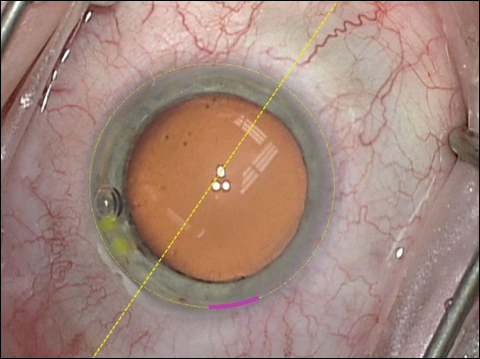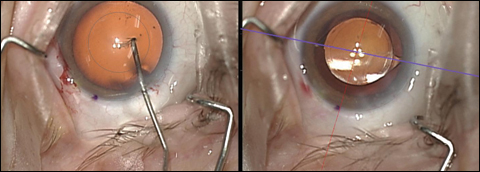Increase accuracy of preop measurements with ‘markerless’ toric IOL alignment techniques
Click Here to Manage Email Alerts
Refractive cataract surgery continues to gain in popularity among both cataract surgeons and their patients because advanced technology and surgical techniques seem to deliver improved visual outcomes. Among cataract surgery patients, corneal astigmatism of greater than 1 D was noted in 40% of eyes in a U.K. study and 50% of eyes in an Italian study, greater than 1.25 D in 27.5% of eyes in a Chinese study, and greater than 2 D in 8% of eyes in a German study.
Optimal optical visual quality is bestowed by attaining uncorrected emmetropia or corrected emmetropia that includes sphere, cylinder, or both sphere and cylinder. With the insertion of an intraocular prosthetic device such as the standard IOL, the spherical correction can be greatly improved toward emmetropia, utilizing preoperative testing devices such as the IOLMaster (Carl Zeiss Meditec), Lenstar (Haag-Streit) and AL-Scan optical biometer (Nidek). This surgical approach serves well for patients with preoperative spherical correction, while those with astigmatism are treated with limbal relaxing incisions and/or postoperative spectacle or contact lens correction.
With continued improvements in IOL technology, we now have the toric IOL, which can potentially bestow the optimal visual acuity after cataract surgery without often requiring any external corrective devices such as glasses or contact lenses. However, a toric IOL needs to be placed on axis to deploy its complete IOL correction to the operated eye. Misalignment of a toric IOL can result in a suboptimal or detrimental surgical outcome. Surgeons have used various intraoperative manual and laser-assisted techniques to facilitate proper toric IOL placement.
In this column, Dr. Peets describes his technique of markerless toric IOL placement.
Thomas “TJ” John, MD
OSN Surgical Maneuvers Editor

Optical biometry with the IOLMaster 500 (Carl Zeiss Meditec) has increased the accuracy of my preoperative cataract surgery measurements with new imaging and reference tools (Callisto, Carl Zeiss Meditec), which have reduced postoperative toric IOL misalignment in my practice. This technique integrates data from the optical biometer into the surgical microscope (OPMI Lumera, Carl Zeiss Meditec) and works primarily by obtaining a reference image of the eye at surgery and matching it to a reference image of the eye obtained by the optical biometer, using limbal vessels as guides. Here is my step-by-step process for increasing the accuracy of my preoperative cataract surgery measurements.
Technique
First, I use optical biometry to produce a reference image that is aligned with vasculature and patient identifiers (Figure 1). Those data are loaded onto a USB stick that I utilize to transfer the data into the reference tool on the day of surgery. After data are loaded, I begin the first process of preparation by accessing each patient’s file. I select the eye that will be operated on, the location of the incision and the width of the incision. If I need to perform a limbal relaxing incision, I add that at this step as well. Next, I inspect the initial reference image and apply my selections.
When surgery starts, I can display the patient’s data and select “start surgery.” Once the patient is prepped and draped, I place the lid speculum and position the microscope over the eye. The reference software obtains a reference image of the eye at surgery and matches it to the reference image obtained from the optical biometer, which I previously uploaded into the software (Figure 2). Grid overlays are displayed over the images, which allow me to visually scan the image and carefully identify limbal blood vessels to make a precise match between the two images. Once I have an exact match, I proceed with surgery.

Images: Peets R



I have the ability to function through the various integrated data injection systems (IDIS), which are visual aids that are injected into the oculus of my microscope. The first visual aid that presents is a reference circle on the limbus, and I can move forward through the visual aids with a click on the foot pedal; the microscope can also be used to toggle through the handles. I toggle through to the IDIS that displays where I will place my incision. The software projects those selections directly on the limbus (Figure 3).
I then make my incision, and I toggle to the next visual aid, which is the capsulorrhexis circle. The eye-tracking software projects this capsulorrhexis circle into my viewer, and then I proceed to perform a continuous curvilinear capsulorrhexis using the guide (Figure 4). The reference software is unique in that it not only shows the size of the circle and projects a perfect circle for users to follow, but it also will center over the angle kappa of the eye. It uses the measurements from the optical biometer to determine the angle kappa. Therefore, it can center the capsulorrhexis right over the visual axis of the eye, rather than just the geometric center of the eye.
Once I remove the cataract and implant the IOL in the bag, I remove all of the viscoelastic from behind the IOL. I turn on the next IDIS aid, which is the axis. The axis is projected, allowing me to rotate my toric IOL so that it is precisely on axis. Finally, I am able to complete the case.
Case series
In a retrospective in-house study looking at 44 eyes marked with patients in the upright position, then laying them back and using a Mendez corneal marker, my colleagues and I analyzed postoperative results on dilated eyes with the slit lamp. We found that 66% of the patients marked in this manner were within 5° of target axis, 34% had greater than 5° of misalignment, and 27.3% had 0.75 D or greater of residual astigmatism by manifest refraction. In a following study, we analyzed 74 eyes using the markerless alignment techniques. All eyes were checked postoperatively with dilated examinations at the slit lamp. We found that 87% were within 3° of target axis, 11% were within 4° of target axis, and one eye out of the 74 was 5° from target axis. Our results improved dramatically from marking the patient in the upright position using corneal markers.
Utilizing overlaid reference images has increased my accuracy of toric IOL placement, which has improved my postoperative results. Improved visual acuity results have increased my patient satisfaction, resulting in higher demand for premium IOLs. I now recommend toric IOLs with greater confidence.
- References:
- Berdahl JP, et al. J Refract Surg. 2017;doi:10.3928/1081597X-20170105-01.
- Chen W, et al. J Cataract Refract Surg. 2013;doi:10.1016/j.jcrs.2012.08.060.
- De Bernardo M, et al. Eur J Ophthalmol. 2014;doi:10.5301/ejo.5000415.
- de Sanctis U, et al. Am J Ophthalmol. 2017;doi:10.1016/j.ajo.2017.01.031.
- Hoffmann PC, et al. J Cataract Refract Surg. 2010;doi:10.1016/j.jcrs.2010.02.025.
- Khan MI, et al. J Cataract Refract Surg. 2011;doi:10.1016/j.jcrs.2011.04.026.
- Lin HY, et al. Clin Ophthalmol. 2017;doi:10.2147/OPTH.S124580.
- For more information:
- Robert Peets, DO, can be reached at Dayton Eye Care, 8216 N. Main St., Dayton, OH 45415; email: peets.robert@yahoo.com.
- Edited by Thomas “TJ” John, MD, a clinical associate professor at Loyola University at Chicago and in private practice in Oak Brook, Tinley Park and Oak Lawn, Ill. He can be reached at email: tjcornea@gmail.com.
Disclosures: Peets and John report no relevant financial disclosures.
